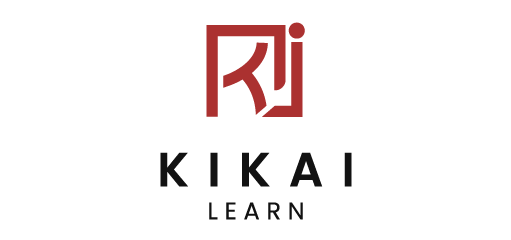ChatGPT & SEO in 2026: How AI Is Redefining Search
After a decade working in SEO, we’ve seen the landscape shift dramatically. What once delivered reliable traffic, keyword optimization, link-building, and chasing ranking spots, no longer guarantees the same results.
- We’re seeing the traffic dip.
- Google LLC and other platforms are increasingly doing what they want to do.
- Links alone no longer guarantee visibility.
- Answers are being served directly in the search interface.
- Impressions may rise, yet click-through rate simply isn’t.
In fact, studies show that nearly 60 % of Google searches end without the user clicking on a result. In the U.S., 58.5% of searches ended in zero clicks in 2024, and in the EU, the figure was approximately 59.7%. Organic traffic is also estimated to drop by 15-25 % thanks to this shift.
In other words, the “zero-click” problem is real and growing.
Solution
“The search bar is no longer where discovery begins; conversations are.” KikaiLearn 2026 SEO Report
Artificial Intelligence has officially rewritten the rules of visibility. In 2026, tools like ChatGPT, Perplexity and AI-powered browsers have evolved from simple tools to decision-engines, platforms where discovery, learning and transactions begin. Traditional SEO built on keywords and backlinks is giving way to something more dynamic. Enter Semantic Experience Optimization (SXO), optimizing for intent, meaning and trust rather than search terms alone. This isn’t the end of SEO , it’s the reinvention of how humans and machines understand each other.
The New Search Landscape
The way users search has fundamentally changed.
People no longer “Google” everything; they ask ChatGPT, Perplexity, or AI-powered browsers that deliver summarized, conversational results.
These new platforms are now the front doors of the internet, reshaping how brands must think about visibility.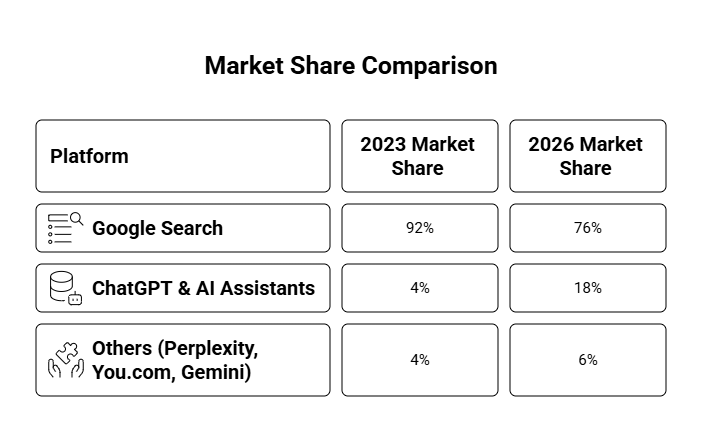
What this means:
- Users expect answers, not links.
- SEO is now about context and conversation.
- Visibility depends on how clearly your content communicates meaning.
Content That Talks Back
Static, keyword-stuffed blogs are fading fast.
AI-driven summaries now pull from human-style, story-driven content, and the best writers are those who sound real, not robotic.
Modern content must do two things at once:
1. Be readable by AI, so it’s structured, scannable, and factual.
2. Be relatable to humans, so it feels emotional, authentic, and conversational. 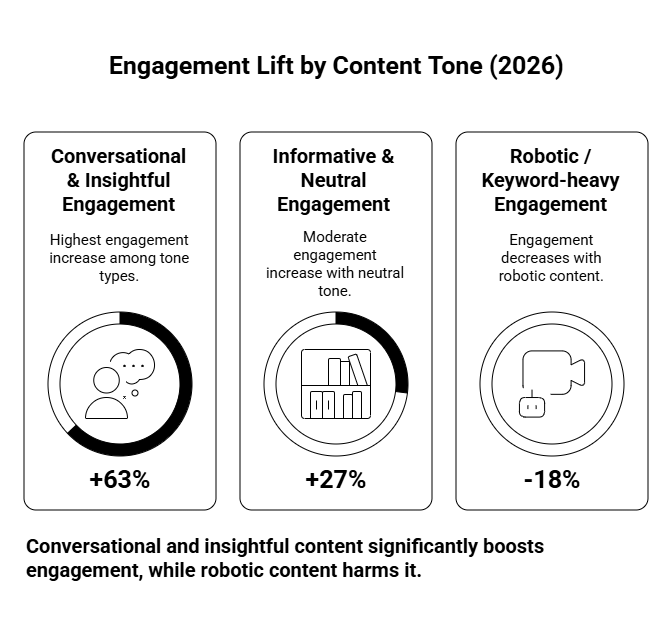
Authority Must Be Proven, Not Claimed
The internet no longer trusts unverified expertise.
Search engines now use authorship signals, linked credentials, and verified identities to rank trustworthy content.
This has expanded Google’s E-E-A-T model into something more powerful:
E-E-A-T-V = Experience, Expertise, Authority, Trust — and Verification
If your brand or author identity isn’t verifiable, you’re invisible.
Search systems now validate credibility through:
- Author metadata and linked profiles
- Citation-backed data
- Consistent cross-platform identity
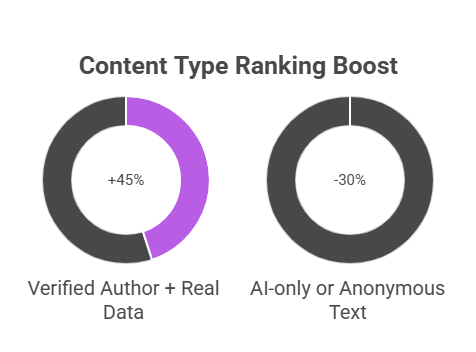
Action Steps:
- Add expert bios and author verification.
- Link to credentials or case studies.
- Build authority through real-world contributions.
The Personalized Search Revolution
In 2026, every user sees a different version of the internet.
AI algorithms now personalize search results by analyzing user tone, behavior, sentiment, and intent.
What one person sees in a search result may look completely different for another.
Example:
A search for “best marketing strategy” might show:
1. To a data-driven user → “AI tools and analytics models.”
2. To a creative user → “Storytelling-based campaigns and emotional branding.”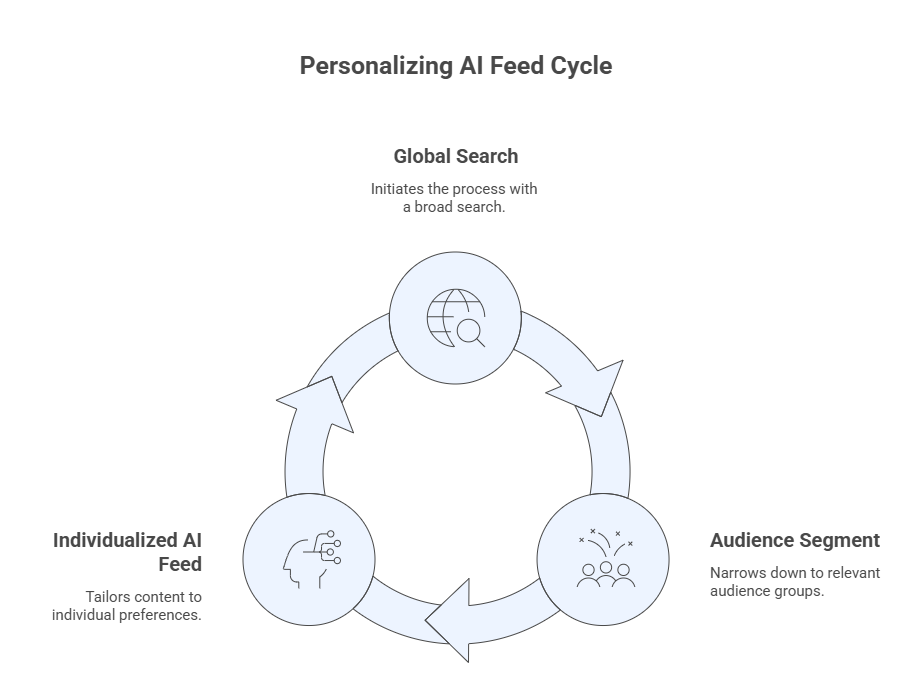
The Marketer’s Mindset Shift
Forget chasing one-size-fits-all rankings. Focus on micro-audiences, adaptive storytelling, and emotional alignment. AI ranks content that connects, not just converts.
Human connection is now the ultimate SEO hack.
The Hybrid Future: AI + SEO
The next era of search is not about AI replacing SEO, it’s about AI and SEO evolving together. Marketers who blend AI efficiency with human creativity are building scalable, sustainable brands.
Hybrid Optimization Formula:
Human Creativity + AI Analytics = Sustainable Growth
How to Apply This:
- Use AI for research, briefs, and ideation.
- Use human experience for emotion, authority, and storytelling.
- Use SEO for visibility, structure, and long-term trust.
GEO: Where You Are Shapes What You See
GEO or Geographic Optimization is redefining how location influences discovery. In 2026, search isn’t just about what people type, but where they are when they do. GEO-driven algorithms now personalize results based on proximity, behavior, and even movement patterns. Whether someone’s looking for “best coffee near me” or a local service provider, GEO ensures results feel hyper-relevant and local-first. For brands, it means optimizing not just websites, but also map listings, localized content, and real-world signals like reviews and check-ins. In simple terms your location is now your ranking factor.
AEO: When Search Learns to Talk Back
AEO: Answer Engine Optimization is the evolution of SEO in the age of AI. Instead of returning a list of links, AI-driven answer engines like ChatGPT, Gemini, and Perplexity now converse with users, delivering instant, context-rich answers. This shift means brands need to optimize for clarity, authority, and conversational tone rather than just keywords. AEO rewards content that sounds human, provides value fast, and reads like an intelligent dialogue. It’s SEO that doesn’t just rank it responds. As more people turn to AI chat interfaces for information, mastering AEO is the key to staying visible in the age of smart search.
GEO + SEO + AEO: The New Search Trinity
Together, GEO, SEO, and AEO form the foundation of what experts call Integrated Search Optimization. GEO ensures your brand shows up locally. SEO ensures it ranks organically. AEO ensures it’s understood by AI. This triad bridges human intent and machine logic helping brands appear across maps, search engines, and conversational AI. In 2026, successful search strategies aren’t built on one of these pillars, but on the connection between all three. The future of visibility isn’t about algorithms or keywords it’s about presence, purpose, and personalization.
How to Optimize for GEO, SEO & AEO (2026 Checklist)
Localize Every Touchpoint (GEO)
Go beyond Google Maps optimize for voice and visual discovery. Add localized keywords in meta tags, maintain consistent NAP (Name, Address, Phone) info across directories, and encourage real user reviews. The goal? Make your brand show up exactly when and where people need it.Design for Intent, Not Just Keywords (SEO)
In 2026, SEO is about understanding motivation. Use AI-driven tools to map search intent; informational, navigational, or transactional and craft content that directly answers those needs. Think fewer keywords, more clarity and depth.Speak the Language of AI (AEO)
Write like you’re talking to both a human and an assistant. Use structured data, FAQs, and clear sentence framing to make your content “readable” by ChatGPT, Gemini, and other AI engines. Every paragraph should answer a question conversationally.Build E-E-A-T-V Credibility
Experience. Expertise. Authority. Trust. Verification.
Add author bios, cite real data sources, show credentials, and integrate proof of authenticity (videos, quotes, or case studies). AI and Google both now value verified human experience as a core ranking signal.Unify Data Across Platforms
GEO, SEO, and AEO all depend on clean, connected data. Sync analytics, CRM insights, and social signals to understand how users find, interact with, and stay with your brand. Data consistency fuels discoverability across search engines and AI interfaces.
Conclusion
The playing field has now been rewritten. If your traffic is dropping, it doesn’t necessarily mean your strategy was flawed, it means the rules have changed. By shifting focus from clicks to clarity, from links to trust, and from terms to meaning, you can adapt and thrive. Embrace SXO, lean into conversations rather than just queries, and position your brand as the trusted voice in a world where answers are served instantly. The future of visibility isn’t just being found, it’s being understood.
Frequently Asked Questions (FAQs)
1. Will ChatGPT replace traditional search engines?
No, ChatGPT will not simply replace traditional search engines like Google, but it will reshape parts of the search journey. ChatGPT and other conversational AI tools excel at discovery, ideation and answering open-ended questions, they handle the “What could I do?” or “Tell me about…” stage very well. Meanwhile, Google still dominates the decision-making and transaction phases: when users are comparing, buying, or looking for trusted sources and multi-step tasks, they still turn to search engines and the web. As the search ecosystem evolves, brands need to show up in both places: in conversational/AI contexts and in classic SERPs. The key is understanding that ChatGPT doesn’t supplant search engines, it complements and sometimes bypasses them. So rather than thinking “search engine vs. ChatGPT”, think “discovery engine + decision engine”.
2. How can brands optimize for AI-driven search?
Brands must move beyond keyword stuffing and backlinks, and focus on semantic clarity, trusted sources, and context-rich content. AI-driven search systems (and the new “answer engines”) interpret meaning, intent and relationships between entities, they don’t just match keywords. So a brand needs to craft content that is clearly structured (use headings, schema markup, FAQs), uses verified data and citations, and addresses user intent in human-friendly language. Context matters: explain the “why”, “how”, “when” of a topic, not just “what”. Also build your authority: AI tools often surface content from sources with strong expertise and trust signals. In effect, you’re optimizing for machines and humans who expect a conversational, helpful tone. This dual focus will help your brand stay visible as search evolves.
3. Are keywords still relevant?
Yes, but their role has changed. Keywords remain a part of optimization, but they’re not the sole driver anymore. What matters now is intent and meaning: groups of related questions (intent clusters) and the emotional or informational triggers around a topic. Instead of targeting one exact phrase, map out: “What does the user want?”, “What question are they asking?”, “What context surrounds this topic?”. Then craft content that addresses the full spectrum of that intent. Keywords act as entry points, but you build around them with sub-topics, synonyms, entities, question-based headings and natural language. This transforms your content from simply “optimized for search” into “optimized for meaning and users”. So yes, still relevant, just smarter.
4. How do I stay visible when users don’t click?
When the “zero-click” phenomenon rises (i.e., users get answers on the SERP itself and don’t click through), visibility isn’t only about clicks anymore. You stay visible by building on-SERP value, featured snippets, FAQ schema, knowledge panels, summary blocks, direct answer placements. Even if the user doesn’t click, being present in the answer box or chat-response builds brand exposure and credibility. So you want to optimize for those placements: answer questions clearly and concisely near the top of your page, structure content so it can be pulled into snippets, use schema markup to signal to search engines. In short: if clicks decline, shift the goal to “being seen and cited” not just “being clicked”. That way you still win visibility even when behavior shifts.
5. What tools help balance ChatGPT & SEO?
To operate well in 2026’s hybrid world of AI-conversation + classic search, you’ll need tools from different categories:
For ideation and conversation-style content: ChatGPT / Jasper. These help you brainstorm topics, simulate user questions, generate natural-language drafts.
For optimization and on-page visibility: SurferSEO / NeuronWriter. These help analyze competitor content, semantic terms, optimization scores.
For depth, topical coverage and content gaps: MarketMuse / Clearscope. Use them to ensure your content isn’t just shallow but covers the full intent and entity network.
For discovery insights into how AI / conversation platforms work: Perplexity / You.com. These help you see how users phrase queries and how answers are being surfaced outside traditional search.
By combining these tools you map ideation → optimization → depth → discovery. That gives you a more complete workflow for 2026 optimization, not just classic SEO.
6. How do I rank in Google in 2026?
Ranking in Google in 2026 means evolving your strategy: it’s not just about keywords and backlinks any more, it’s about experience, trust, relevance and entity-authority. First, you must demonstrate strong E-E-A-T (Experience, Expertise, Authoritativeness, Trustworthiness). Google gives more weight than ever to content backed by real expertise and credible sources. Next, you need to optimize for meaning: structure content around user intent, answer real questions, provide context and related topics. Use schema markup (FAQ, HowTo, Article) so your content is “machine-readable”. Also, become a recognized topic-entity: make sure your brand or authors are cited across the web, link and mention authority is strong. Lastly, measure visibility, not just traffic. With more zero-click searches, being ranked obviously may not bring clicks, but if you appear in answer boxes, you still win. So invest in authority, topical depth and structured markup to stay ranking-ready.
7. My impressions are dropping, what should I do?
A drop in impressions doesn’t always mean your content is failing, it may mean search behavior is shifting and your visibility strategy needs an update. First, audit your Search Console data: check pages where impressions are falling and identify changes in SERP features (snippets, AI overviews) that may now dominate your keywords. Second, refresh your content: update statistics, address more related questions, restructure to answer user intent more fully. Third, optimize for zero-click opportunities: add FAQ and HowTo schema, insert concise answer blocks within your content that could appear in featured snippets or answer boxes. Fourth, strengthen brand signals: ensure your content has credible citations, authorship, consistent brand mentions and links, so you remain a trusted source. Fifth, track new metrics: look at impression share in SERPs, snippet appearances, branded query share, not just conventional click-throughs. By pivoting your focus from “traffic volume” to “visibility and authority”, you can respond to dropping impressions proactively.
8. What is AEO in simple terms?
AEO means optimizing your content so AI tools like ChatGPT or Perplexity can understand it and use it to answer questions directly. Instead of ranking on a search page, your content becomes part of an AI conversation.
9. How do I make my website AEO-friendly?
Write in a clear, conversational tone, use FAQs, and include structured data. The goal is to make your answers easy for AI to pick up, summarize, and share with users.
10. How does GEO help my business?
GEO helps your brand appear in local searches like “near me” results or location-based recommendations. It connects your business to people physically near you looking for what you offer.
11. What’s one easy GEO optimization tip?
Keep your Google Business Profile updated add photos, reviews, and accurate info. It’s the simplest way to boost your visibility in local and voice searches.
Start your journey now with the KikaiLearn Prompt Engineering Mastery Course a practical, non-coding path designed for marketers eager to thrive in 2025 and beyond.
